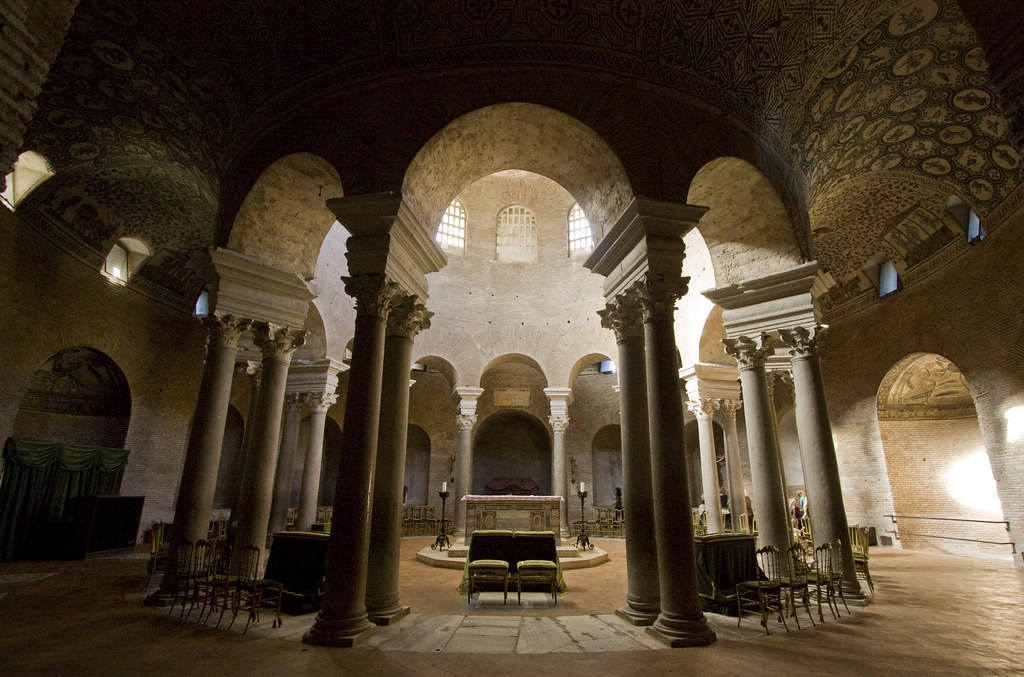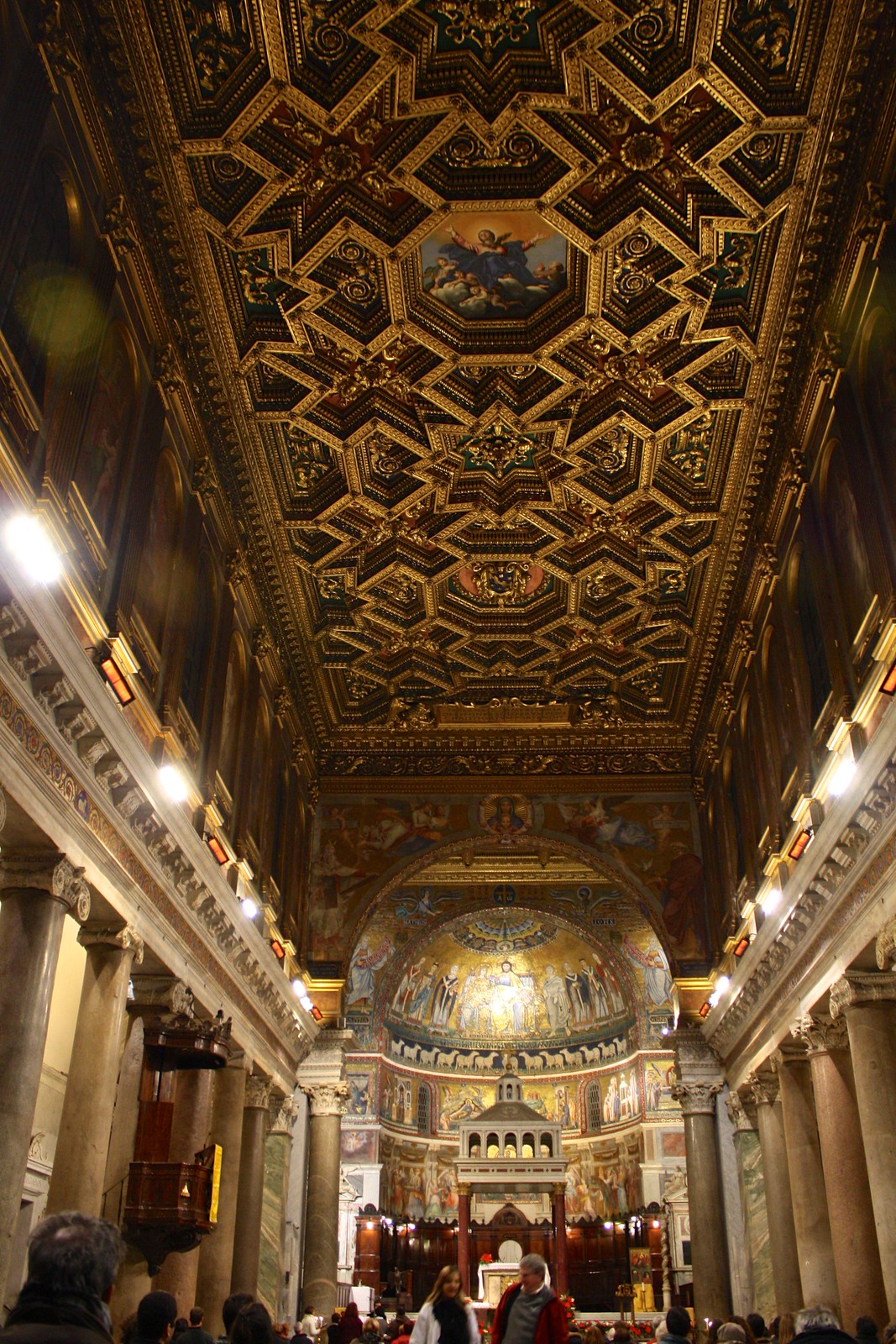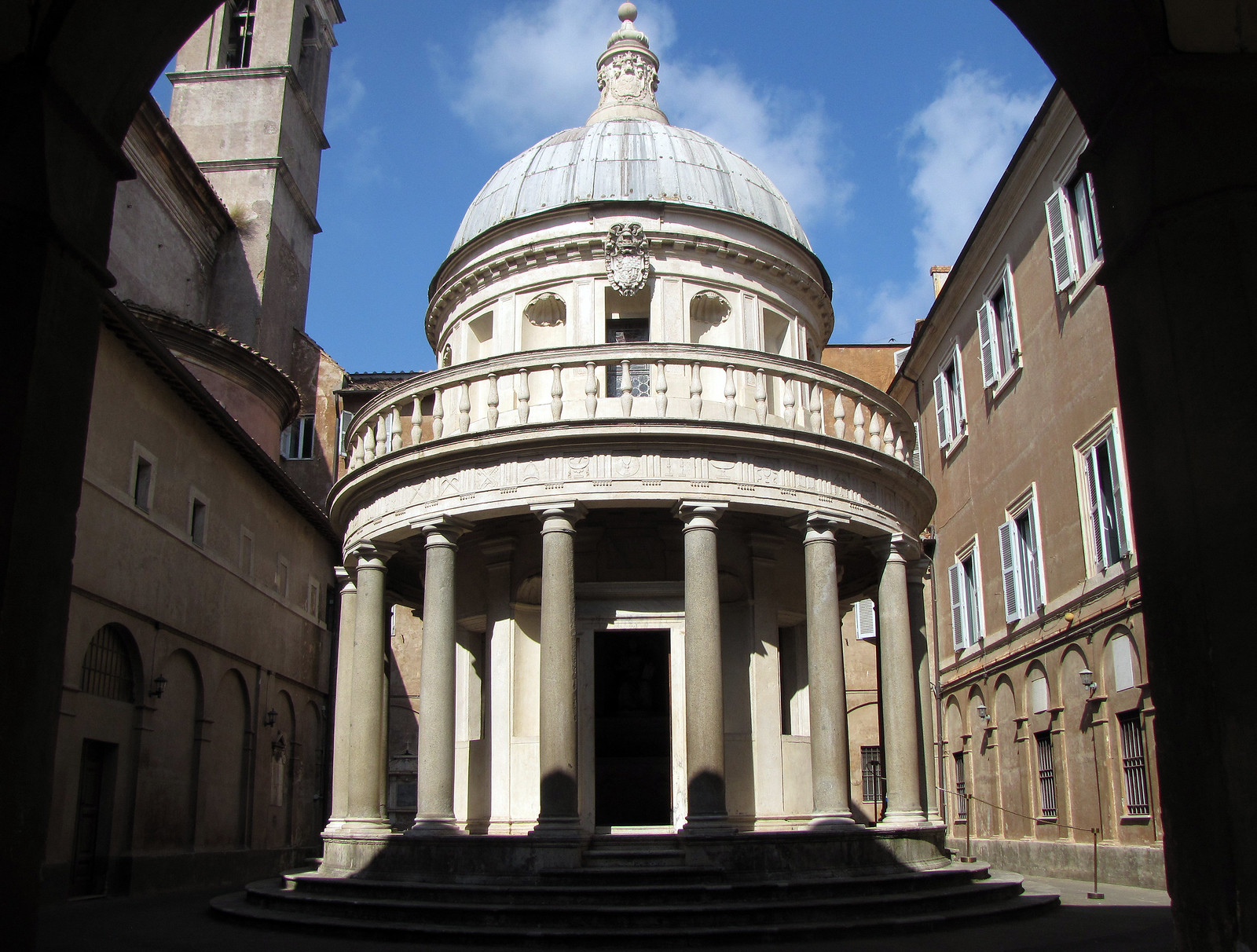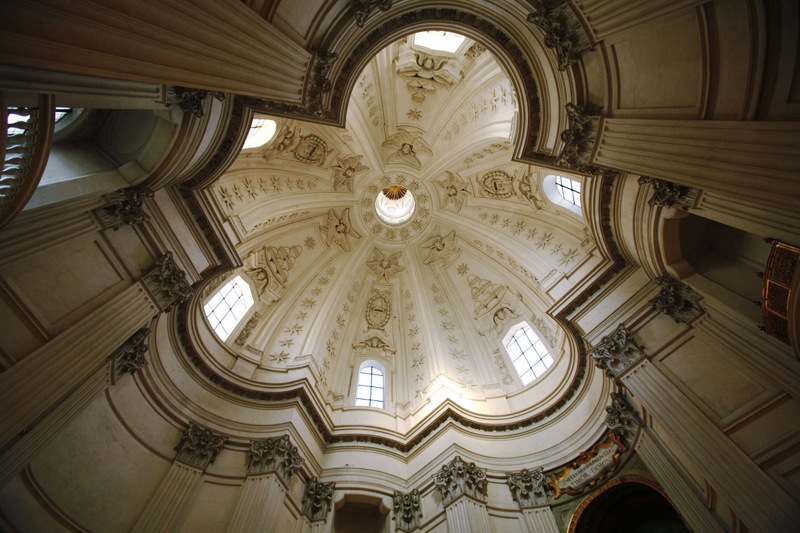My 10 Favorite Churches in Rome
When I was back home in Texas last summer, I decided to educate myself on all the architectural styles that have left their mark across the centuries in western Europe. I had a vague idea of what Romanesque, Gothic, or Classical Revival buildings looked like, but I would have been stumped had you asked me to explain what exactly made each time period stand out from the others. So I embarked on History of Architecture I, a free iTunes U course taught by Ohio State University professor Jacqueline Gargus. Although I have no background in architecture, engineering, or design, I found it super easy to jump right to Prof. Gargus’s lively discussion of western architecture.
Watching these lectures really helped me to grow in my knowledge of the major styles, and I now feel comfortable explaining the differences and revolutionary ideas of each era. I also enjoyed being introduced to some of the most significant examples of each architectural style, many of them in Italy, the cradle of the Renaissance and Baroque eras. I was understandably very excited to head to Rome this December so I could see, in person, such important churches like the ones I’m going to talk about below. (#NerdAlert warning!)
Although Rome is home to hundreds of gorgeous churches, I’d like to share with y’all a few of them that really stood out to me. Starting in the northern Piazza del Popolo, I’ll move in a clockwise spiral, ending in the Pantheon neighborhood.
The Church of “St. Mary of the People” has a lot going for it. First of all, it’s filled to the brim with opulent Baroque-style side chapels, many of which hold dozens of works of art like Renaissance painter Caravaggio’s The Crucifixion of St. Peter and The Conversion of St. Paul.
The church also sits just inside the old city walls at a commanding position on the north side of the busy Piazza del Popolo. According to tradition, the remains of infamous Emperor Nero were said to be buried near the location of the present-day church, and during the Middle Ages, his ghost and/or demons in the form of crows apparently perturbed the people of Rome so much that the pope had Nero’s urn emptied into the Tiber River and a demonic tree—the crows’ favorite haunt—cut down to make way for today’s church.
But what Santa Maria del Popolo is made of fascinated me the most: white travertine marble that, according to Rick Steves, was plundered from the Colosseum when it was used as a quarry in Baroque times. Buildings like this are why merely a third of the original ancient stadium remains!
Far outside the old city, there’s an early Christian mausoleum that dates to the 300s CE. Currently attached to the Church of Sant’Agnese, the Mausoleum of Santa Costanza beautifully encapsulates the transition from ancient Roman to early medieval architecture with its unique, “in-the-round” layout. Although dedicated to St. Constance—a mythical character based on Constantia, the real-life daughter of Emperor Constantine—the mausoleum was probably built for Constantia’s sister, Helena.
The original red porphyry sarcophagus that was once here can now be found in the Vatican Museums. Regardless of who exactly is commemorated in this place, the barrel-vaulted ceilings that cover the circular ambulatory have somehow managed to preserve their early Christian mosaics. I wasn’t able to see this church because of awkward opening hours on Christmas Day, but I would love to should I ever return.
I’d estimate 95% of visitors to this church come to see a work of art showcased in one of the side-chapels: a famous sculpture by Bernini called The Ecstasy of St. Teresa. This two-part statue group depicts an angel piercing a nun, Teresa of Ávila, who swoons in the love and joy of God. Teresa’s thick robes tumble down to the viewer, and gilded rods direct light down from heaven (literally—there’s a skylight). On either side, Bernini depicted the donors to the chapel as if they were peeking down from theater boxes—using perspective to add a sense of depth to the flat sculptures.
The rest of the tiny Baroque church (by Roman standards, *ahem*) is similarly decorated in warm, polychrome marble, lots of gold, and angelic statues that cling to the ceiling.
From the moment I first heard about this church when I took that iTunes U class this summer, I fell in love with it. Built in an awkward spot at a busy intersection that sports “four fountains,” this church dedicated to St. Charles single-handedly changed the way I think about Baroque architecture. Before, I always thought of it as overloaded, gloppy, and snobby. But San Carlo’s beautiful, unconventional wavy façade made such an impression on me that now I really appreciate this time period, which was all about breaking the rules of classical architecture (but still keeping the same “vocabulary” or elements) and introducing emotion and movement.
Along with #6 below and two other Roman churches, Santa Maria Maggiore holds the status of “papal basilica” and is technically the territory of the Vatican City, kind of like an embassy. This church’s name is usually translated as “St. Mary Major” to reflect that it is Rome’s main place of Christian worship dedicated to Mary, but its vast size alone wasn’t responsible for this status.
Back in the year 431, the Council of Ephesus was convened to bring together Christian leaders from across the Roman world to deal with the teachings of potential heretic Nestorius, who said the Messiah was two persons—Christ, the Son of God, and Jesus, the man. Nestorius was declared a heretic at this council, and Mary was also declared “Mother of God,” not merely the mother of a human child. To celebrate this decision, the pope had this church re-built in the 400s.
The church that you can see today dates back to medieval times: the simple basilica plan culminates in stunning, golden mosaics that cover the entire apse in the back. As the story goes, the gold on the dazzling coffered ceiling was some of the first to come from the Spanish conquest of the Americas. And the while the Romanesque bell tower still stands outside, it’s been subsumed into a grand, wavy Baroque façade that makes the cross-shaped church look more like a palace.
Called “St. John Lateran” in English, this church is technically the cathedral of Rome since it’s the seat of the Bishop of Rome, a.k.a. the Pope. During the reign of Constantine, the Lateran family palace was given to the popes, who soon took up residence and used its basilica or business hall as a church. It was here that the popes lived until they moved to Avignon in southern France in the 1300s. When they came back to Rome, they ultimately settled in the new complex on Vatican hill, where they have remained ever since.
Like Santa Maria Maggiore, this church follows the traditional Latin-cross basilica floor plan: a large central nave with shorter aisles on either side and a transept or perpendicular crossing. As you proceed from the entrance to the altar, larger-than-life statues of the Twelve Apostles fill niches in the structural pillars, and in the apse to the back, you can see gleaming religious mosaics that have come down from the Middle Ages.
Outside, the largest Egyptian obelisk in the world dominates the piazza, and in a building nearby are housed the Holy Stairs—what is purported to be the steps to Pilate’s palace that Jesus went up to stand trial before he was crucified. According to legend, Constantine’s mother Helen went to Jerusalem, where she fetched them and brought them back to Rome. Today, they’re covered in creaky walnut wood with little looking holes that point out possible drops of blood. Faithful Catholics ascend the stairs on their knees in prayerful piety.
The Church of Santa Maria in Cosmedin is a little bit of a tourist trap: the ancient Roman sewer cap or fountain piece called La Bocca della Verità (“The Mouth of Truth”) draws tourists to put their hands in the face’s mouth. According to medieval thought, if you placed your hand in the Bocca’s mouth and lied, it would chomp your hand off right then and there! This sewer cap was popularized by American and Japanese films in the past half-century, and nowadays, most people stand in line, get their picture, and immediately hop back on their bus.
But the attached church is worth at least a few minutes of your time after snapping your shot. This church began as a diakonia where early Christians would help the poor, and it later housed a community of Greek Christians. In the Middle Ages, it was ornately decorated, from which its present Greek-based name, Cosmedin, derives. Today’s Romanesque church still holds remnants of its medieval frescoes, but don’t forget to look down at the dizzying Cosmatesque-style mosaic floors.
Like Santa Maria Maggiore (#5) and San Giovanni in Laterano (#6) above, Santa Maria in Trastevere follows the traditional Roman basilica plan and is also one of the oldest churches in the city; tradition has it that a house church met here in the 200s CE! The church we can see today in the Trastevere neighborhood (“beyond the Tiber river”) dates to medieval times, when the great columns in the central nave were lifted from ancient ruins and the Baths of Caracalla became a quarry for construction projects.
Original mosaics from the Middle Ages still cover the apse in the back, and the gilded ceiling might make you fall over if you crane your neck back too far to appreciate it. The Trastevere neighborhood has a reputation as a grittier and less touristy part of town than the historic center on the other side of the river, but the area is a really beautiful part of the city that you should totally check out—along with one of the oldest continuously used churches anywhere.
On Christmas Day when I did a mini-pilgrimage of Roman churches, I had mixed luck: some churches like Santa Maria Maggiore and San Giovanni in Laterano were open all day long, but the Mausoleum of Santa Costanza opened in the afternoon (I learned this when I showed up bright and early) and the Church of San Pietro in Montorio closed before lunch (which I found out after lunch). Oh well.
I had wanted to check out the courtyard in this church because it houses the tempietto (“little temple”) designed by Renaissance architect Bramante. I learned about this chapel in my iTunes U course: it’s one of the most perfect examples of Renaissance architecture in that it incorporates classical elements like ordered columns, pilasters, and a dome, all in an idealized circular space. To Catholics, it’s especially significant because, as a martyrium, it commemorates the traditional mountaintop location where St. Peter (San Pietro in Italian) was crucified in the first century CE. It’s just too bad the church was closed for the day when I showed up!
Of all the churches I attempted to visit (but couldn’t), I was most disappointed at missing out on this one. Dedicated to St. Yves, the alla Sapienza part refers to the fact that it’s a chapel amidst a palace in the University of Rome, called La Sapienza (“wisdom” or “knowledge”). What makes it so architecturally significant is that Baroque architect Borromini designed the plan as a triangle with circles intersecting along the edges and chopping off the points, creating a dizzying, geometric, and theological combination of flowing, lively walls.
Have you been to (or even heard of) any of these churches before? Or do you get “church fatigue” when traveling after seeing one too many cathedrals? Comment in the discussion below!

 |
| Ceiling of the Church of Santa Maria Maggiore |
Watching these lectures really helped me to grow in my knowledge of the major styles, and I now feel comfortable explaining the differences and revolutionary ideas of each era. I also enjoyed being introduced to some of the most significant examples of each architectural style, many of them in Italy, the cradle of the Renaissance and Baroque eras. I was understandably very excited to head to Rome this December so I could see, in person, such important churches like the ones I’m going to talk about below. (#NerdAlert warning!)
Although Rome is home to hundreds of gorgeous churches, I’d like to share with y’all a few of them that really stood out to me. Starting in the northern Piazza del Popolo, I’ll move in a clockwise spiral, ending in the Pantheon neighborhood.
1) Santa Maria del Popolo
 |
| (Source: Kræn Bech-Petersen) |
The Church of “St. Mary of the People” has a lot going for it. First of all, it’s filled to the brim with opulent Baroque-style side chapels, many of which hold dozens of works of art like Renaissance painter Caravaggio’s The Crucifixion of St. Peter and The Conversion of St. Paul.
The church also sits just inside the old city walls at a commanding position on the north side of the busy Piazza del Popolo. According to tradition, the remains of infamous Emperor Nero were said to be buried near the location of the present-day church, and during the Middle Ages, his ghost and/or demons in the form of crows apparently perturbed the people of Rome so much that the pope had Nero’s urn emptied into the Tiber River and a demonic tree—the crows’ favorite haunt—cut down to make way for today’s church.
But what Santa Maria del Popolo is made of fascinated me the most: white travertine marble that, according to Rick Steves, was plundered from the Colosseum when it was used as a quarry in Baroque times. Buildings like this are why merely a third of the original ancient stadium remains!
2) Sant’Agnese (Mausoleum of Santa Costanza)
 |
| (Source: Lawrence Lew) |
Far outside the old city, there’s an early Christian mausoleum that dates to the 300s CE. Currently attached to the Church of Sant’Agnese, the Mausoleum of Santa Costanza beautifully encapsulates the transition from ancient Roman to early medieval architecture with its unique, “in-the-round” layout. Although dedicated to St. Constance—a mythical character based on Constantia, the real-life daughter of Emperor Constantine—the mausoleum was probably built for Constantia’s sister, Helena.
The original red porphyry sarcophagus that was once here can now be found in the Vatican Museums. Regardless of who exactly is commemorated in this place, the barrel-vaulted ceilings that cover the circular ambulatory have somehow managed to preserve their early Christian mosaics. I wasn’t able to see this church because of awkward opening hours on Christmas Day, but I would love to should I ever return.
3) Santa Maria della Vittoria
 |
| The side chapel |
I’d estimate 95% of visitors to this church come to see a work of art showcased in one of the side-chapels: a famous sculpture by Bernini called The Ecstasy of St. Teresa. This two-part statue group depicts an angel piercing a nun, Teresa of Ávila, who swoons in the love and joy of God. Teresa’s thick robes tumble down to the viewer, and gilded rods direct light down from heaven (literally—there’s a skylight). On either side, Bernini depicted the donors to the chapel as if they were peeking down from theater boxes—using perspective to add a sense of depth to the flat sculptures.
The rest of the tiny Baroque church (by Roman standards, *ahem*) is similarly decorated in warm, polychrome marble, lots of gold, and angelic statues that cling to the ceiling.
4) San Carlo alle Quattro Fontane
 |
| Exterior façade |
From the moment I first heard about this church when I took that iTunes U class this summer, I fell in love with it. Built in an awkward spot at a busy intersection that sports “four fountains,” this church dedicated to St. Charles single-handedly changed the way I think about Baroque architecture. Before, I always thought of it as overloaded, gloppy, and snobby. But San Carlo’s beautiful, unconventional wavy façade made such an impression on me that now I really appreciate this time period, which was all about breaking the rules of classical architecture (but still keeping the same “vocabulary” or elements) and introducing emotion and movement.
5) Santa Maria Maggiore
 |
| Inside the central nave on Christmas Day |
Along with #6 below and two other Roman churches, Santa Maria Maggiore holds the status of “papal basilica” and is technically the territory of the Vatican City, kind of like an embassy. This church’s name is usually translated as “St. Mary Major” to reflect that it is Rome’s main place of Christian worship dedicated to Mary, but its vast size alone wasn’t responsible for this status.
Back in the year 431, the Council of Ephesus was convened to bring together Christian leaders from across the Roman world to deal with the teachings of potential heretic Nestorius, who said the Messiah was two persons—Christ, the Son of God, and Jesus, the man. Nestorius was declared a heretic at this council, and Mary was also declared “Mother of God,” not merely the mother of a human child. To celebrate this decision, the pope had this church re-built in the 400s.
The church that you can see today dates back to medieval times: the simple basilica plan culminates in stunning, golden mosaics that cover the entire apse in the back. As the story goes, the gold on the dazzling coffered ceiling was some of the first to come from the Spanish conquest of the Americas. And the while the Romanesque bell tower still stands outside, it’s been subsumed into a grand, wavy Baroque façade that makes the cross-shaped church look more like a palace.
6) San Giovanni in Laterano
 |
| Christmas Day mass inside |
Called “St. John Lateran” in English, this church is technically the cathedral of Rome since it’s the seat of the Bishop of Rome, a.k.a. the Pope. During the reign of Constantine, the Lateran family palace was given to the popes, who soon took up residence and used its basilica or business hall as a church. It was here that the popes lived until they moved to Avignon in southern France in the 1300s. When they came back to Rome, they ultimately settled in the new complex on Vatican hill, where they have remained ever since.
Like Santa Maria Maggiore, this church follows the traditional Latin-cross basilica floor plan: a large central nave with shorter aisles on either side and a transept or perpendicular crossing. As you proceed from the entrance to the altar, larger-than-life statues of the Twelve Apostles fill niches in the structural pillars, and in the apse to the back, you can see gleaming religious mosaics that have come down from the Middle Ages.
Outside, the largest Egyptian obelisk in the world dominates the piazza, and in a building nearby are housed the Holy Stairs—what is purported to be the steps to Pilate’s palace that Jesus went up to stand trial before he was crucified. According to legend, Constantine’s mother Helen went to Jerusalem, where she fetched them and brought them back to Rome. Today, they’re covered in creaky walnut wood with little looking holes that point out possible drops of blood. Faithful Catholics ascend the stairs on their knees in prayerful piety.
7) Santa Maria in Cosmedin
 |
| La bocca della verità |
The Church of Santa Maria in Cosmedin is a little bit of a tourist trap: the ancient Roman sewer cap or fountain piece called La Bocca della Verità (“The Mouth of Truth”) draws tourists to put their hands in the face’s mouth. According to medieval thought, if you placed your hand in the Bocca’s mouth and lied, it would chomp your hand off right then and there! This sewer cap was popularized by American and Japanese films in the past half-century, and nowadays, most people stand in line, get their picture, and immediately hop back on their bus.
But the attached church is worth at least a few minutes of your time after snapping your shot. This church began as a diakonia where early Christians would help the poor, and it later housed a community of Greek Christians. In the Middle Ages, it was ornately decorated, from which its present Greek-based name, Cosmedin, derives. Today’s Romanesque church still holds remnants of its medieval frescoes, but don’t forget to look down at the dizzying Cosmatesque-style mosaic floors.
8) Santa Maria in Trastevere
 |
| Stunning ceiling |
Like Santa Maria Maggiore (#5) and San Giovanni in Laterano (#6) above, Santa Maria in Trastevere follows the traditional Roman basilica plan and is also one of the oldest churches in the city; tradition has it that a house church met here in the 200s CE! The church we can see today in the Trastevere neighborhood (“beyond the Tiber river”) dates to medieval times, when the great columns in the central nave were lifted from ancient ruins and the Baths of Caracalla became a quarry for construction projects.
Original mosaics from the Middle Ages still cover the apse in the back, and the gilded ceiling might make you fall over if you crane your neck back too far to appreciate it. The Trastevere neighborhood has a reputation as a grittier and less touristy part of town than the historic center on the other side of the river, but the area is a really beautiful part of the city that you should totally check out—along with one of the oldest continuously used churches anywhere.
9) San Pietro in Montorio
 |
| The tempietto (Source: Steven Zucker) |
On Christmas Day when I did a mini-pilgrimage of Roman churches, I had mixed luck: some churches like Santa Maria Maggiore and San Giovanni in Laterano were open all day long, but the Mausoleum of Santa Costanza opened in the afternoon (I learned this when I showed up bright and early) and the Church of San Pietro in Montorio closed before lunch (which I found out after lunch). Oh well.
I had wanted to check out the courtyard in this church because it houses the tempietto (“little temple”) designed by Renaissance architect Bramante. I learned about this chapel in my iTunes U course: it’s one of the most perfect examples of Renaissance architecture in that it incorporates classical elements like ordered columns, pilasters, and a dome, all in an idealized circular space. To Catholics, it’s especially significant because, as a martyrium, it commemorates the traditional mountaintop location where St. Peter (San Pietro in Italian) was crucified in the first century CE. It’s just too bad the church was closed for the day when I showed up!
10) Sant’Ivo alla Sapienza
 |
| (Source: Jøran Pecher) |
Of all the churches I attempted to visit (but couldn’t), I was most disappointed at missing out on this one. Dedicated to St. Yves, the alla Sapienza part refers to the fact that it’s a chapel amidst a palace in the University of Rome, called La Sapienza (“wisdom” or “knowledge”). What makes it so architecturally significant is that Baroque architect Borromini designed the plan as a triangle with circles intersecting along the edges and chopping off the points, creating a dizzying, geometric, and theological combination of flowing, lively walls.
Have you been to (or even heard of) any of these churches before? Or do you get “church fatigue” when traveling after seeing one too many cathedrals? Comment in the discussion below!

